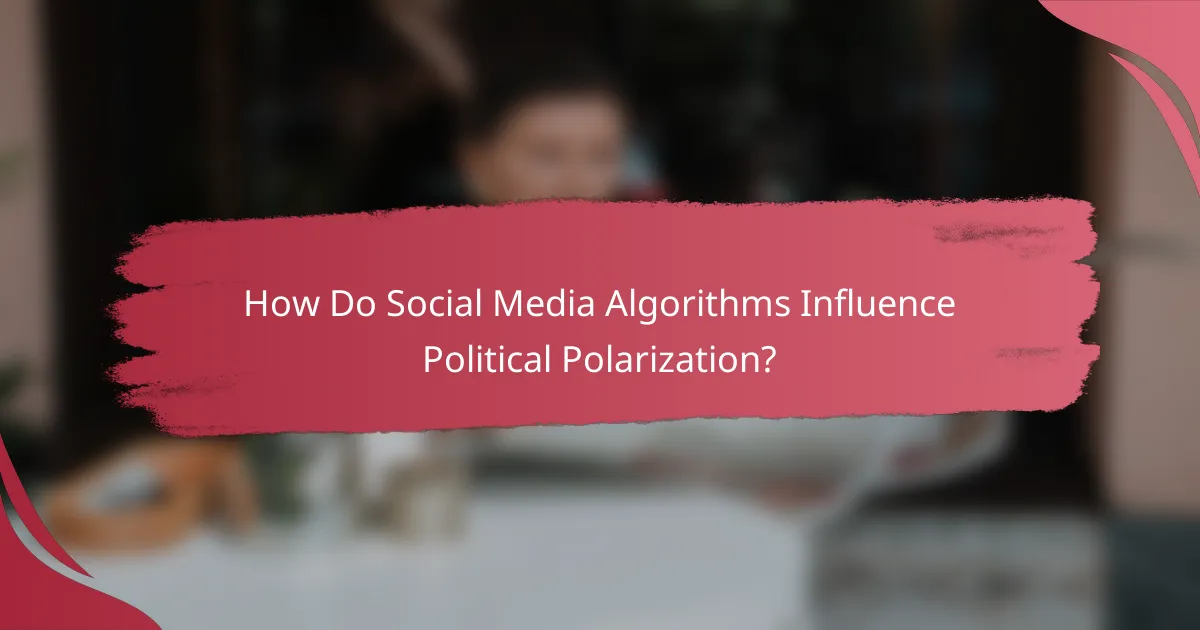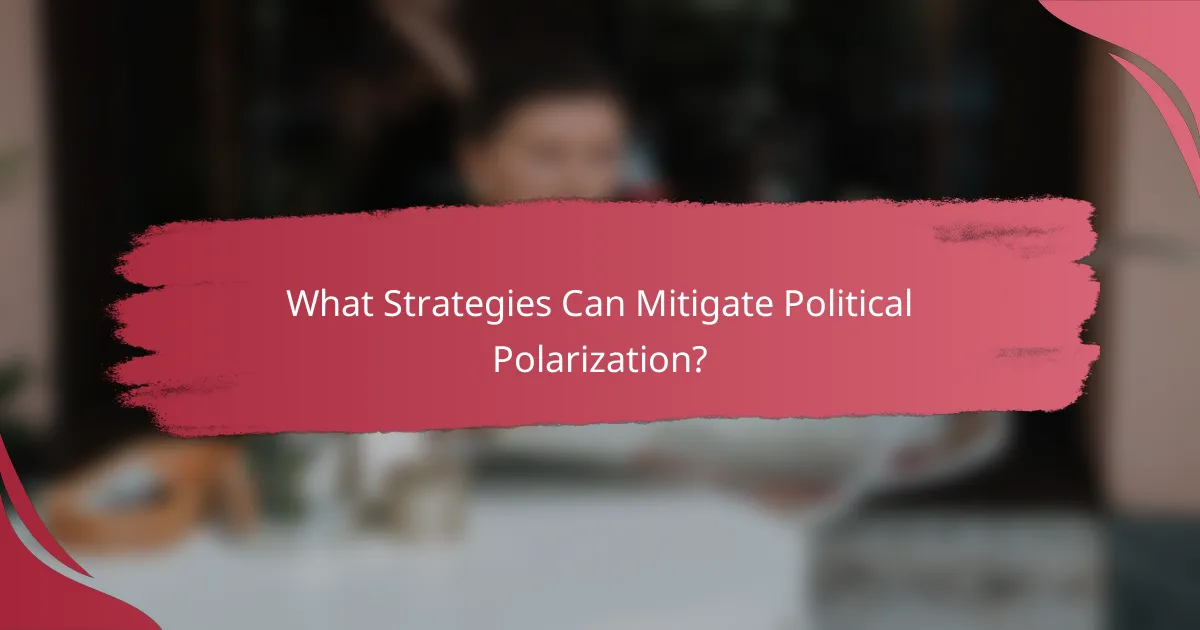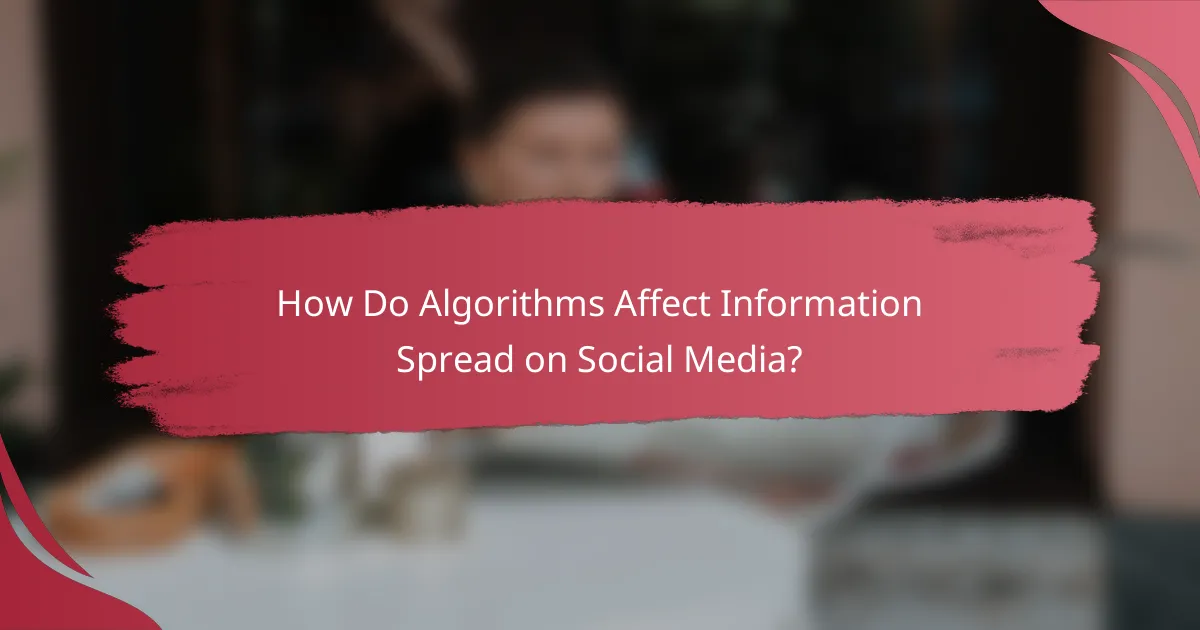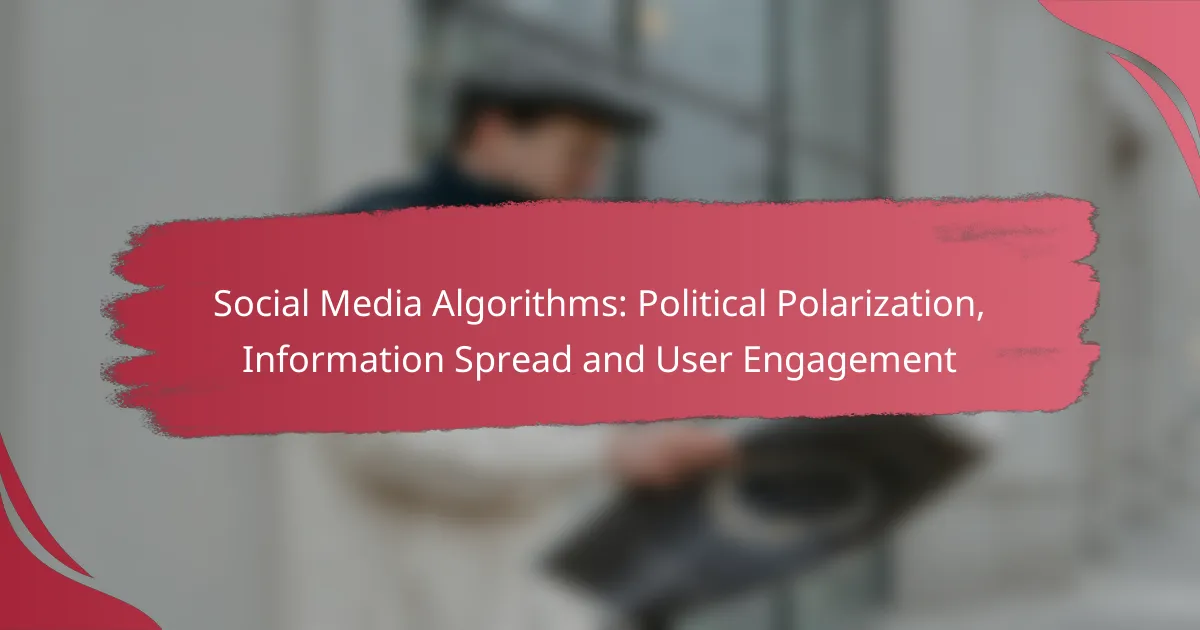Social media algorithms play a pivotal role in shaping political polarization by curating content that reinforces users’ preexisting beliefs, often resulting in a limited perspective. By prioritizing engagement, these algorithms can amplify extreme viewpoints, further entrenching divisions among users. Addressing this issue requires enhancing algorithm transparency, educating users, and promoting a diverse range of content to foster a more balanced information ecosystem.

How Do Social Media Algorithms Influence Political Polarization?
Social media algorithms significantly shape political polarization by curating content that aligns with users’ existing beliefs, often leading to a narrow worldview. These algorithms prioritize engagement, which can amplify extreme viewpoints and create divisions among users.
Algorithmic echo chambers
Algorithmic echo chambers occur when users are repeatedly exposed to similar viewpoints, reinforcing their beliefs and isolating them from opposing perspectives. This phenomenon is driven by algorithms that prioritize content based on user interactions, resulting in a feedback loop that limits exposure to diverse opinions.
For example, a user who frequently engages with political content from a specific ideology may find their feed dominated by similar posts, while dissenting views are filtered out. This can lead to increased polarization as individuals become more entrenched in their beliefs.
Content prioritization effects
Content prioritization by algorithms can skew the information landscape, favoring sensational or emotionally charged posts that drive higher engagement. This often means that nuanced discussions or factual reporting are overshadowed by more polarizing content, which can misinform users and deepen divisions.
Platforms may prioritize posts that generate strong reactions, such as likes or shares, over those that promote constructive dialogue. As a result, users may perceive a distorted reality where extreme views appear more prevalent than they actually are.
User engagement metrics
User engagement metrics, such as likes, shares, and comments, play a crucial role in how algorithms function. These metrics inform platforms about what content resonates with users, leading to further amplification of similar posts. This can create a cycle where only the most engaging, often polarizing, content is promoted.
To mitigate the effects of engagement-driven polarization, users can diversify their feeds by following accounts with varying perspectives. Additionally, being mindful of the content they engage with can help break the cycle of echo chambers and promote a more balanced information diet.

What Strategies Can Mitigate Political Polarization?
To mitigate political polarization, strategies must focus on enhancing algorithm transparency, educating users, and promoting content diversity. These approaches aim to create a more informed user base and a balanced information ecosystem.
Algorithm transparency initiatives
Algorithm transparency initiatives involve making the inner workings of social media algorithms more understandable to users. By providing insights into how content is prioritized and displayed, platforms can help users recognize potential biases and the factors influencing their feeds.
For example, platforms could offer users a dashboard that shows how their interactions shape the content they see. This transparency may encourage users to seek out diverse viewpoints and reduce echo chambers.
User education programs
User education programs aim to inform individuals about the effects of algorithms on their news consumption and social interactions. These programs can include workshops, online courses, or informational campaigns that teach critical thinking skills and media literacy.
Effective education can empower users to identify misinformation and understand the importance of engaging with a variety of perspectives. For instance, social media platforms might collaborate with educational institutions to develop resources that promote healthy online habits.
Content diversity promotion
Content diversity promotion focuses on encouraging users to engage with a broader range of viewpoints and sources. This can be achieved through algorithm adjustments that prioritize diverse content or by featuring recommendations from various political perspectives.
Platforms might implement features that highlight trending topics from different ideological angles or create curated feeds that include a mix of viewpoints. Encouraging users to follow accounts outside their usual preferences can also foster a more balanced information diet.

How Do Algorithms Affect Information Spread on Social Media?
Algorithms play a crucial role in determining how information spreads on social media by prioritizing certain types of content based on user engagement. They analyze user behavior to promote posts that are likely to generate more interactions, which can lead to rapid dissemination of specific information, often amplifying polarizing viewpoints.
Viral content mechanics
Viral content mechanics refer to the processes that enable certain posts to gain widespread attention quickly. Factors such as shareability, emotional resonance, and trending topics contribute to a post’s potential to go viral. For example, content that evokes strong emotions, like humor or outrage, tends to be shared more frequently, increasing its visibility across platforms.
Social media platforms often use engagement metrics, such as likes, shares, and comments, to identify and promote viral content. This can create a feedback loop where popular posts receive even more exposure, further enhancing their reach.
Influencer impact
Influencers significantly affect information spread on social media by leveraging their large followings to amplify messages. When an influencer shares a post, it can quickly reach thousands or even millions of users, often shaping public opinion and trends. Brands frequently collaborate with influencers to promote products or ideas, capitalizing on their ability to engage audiences effectively.
However, the influence of these individuals can also lead to the spread of misinformation if they share unverified content. Users should critically evaluate the credibility of the information shared by influencers to avoid falling prey to misleading narratives.
Algorithmic bias in content selection
Algorithmic bias occurs when social media algorithms favor certain types of content over others, often unintentionally promoting a narrow range of perspectives. This can lead to echo chambers where users are primarily exposed to viewpoints that reinforce their existing beliefs, contributing to political polarization. For instance, algorithms may prioritize sensational or emotionally charged content, sidelining more balanced discussions.
To mitigate algorithmic bias, platforms are increasingly being called upon to improve transparency in how content is selected and displayed. Users can take proactive steps by diversifying their sources of information and actively seeking out varied viewpoints to counteract the effects of biased algorithms.

What Role Does User Engagement Play in Algorithm Performance?
User engagement significantly influences algorithm performance by determining what content is prioritized and distributed across social media platforms. Higher engagement metrics, such as likes, shares, and comments, signal to algorithms that content is valuable, leading to increased visibility and reach.
Engagement-driven content creation
Content creators often tailor their posts to maximize user engagement, focusing on topics that resonate with their audience. This can include using eye-catching visuals, provocative headlines, or trending themes to capture attention. For instance, posts that elicit strong emotional responses tend to generate more interactions, which in turn boosts their algorithmic ranking.
Creators should consider their target demographic’s preferences and behaviors when designing content. Engaging formats like polls, quizzes, and interactive videos can enhance user participation and drive further engagement.
User feedback loops
User feedback loops occur when engagement metrics influence future content recommendations, creating a cycle that reinforces certain types of content. For example, if a user frequently interacts with political content, algorithms may prioritize similar posts, leading to a more polarized information diet. This feedback can inadvertently narrow users’ exposure to diverse viewpoints.
To mitigate the effects of feedback loops, users can actively seek out varied content and engage with different topics. This practice helps diversify their feed and reduces the risk of echo chambers forming.
Behavioral targeting strategies
Behavioral targeting strategies utilize data on user interactions to deliver personalized content that aligns with individual preferences. Social media platforms analyze past behavior, such as likes and shares, to predict what users are likely to engage with next. This targeted approach can enhance user satisfaction but may also contribute to polarization by limiting exposure to contrasting perspectives.
Users should be aware of how their engagement shapes their online experience. Adjusting privacy settings and exploring content outside their usual interests can help counteract the effects of behavioral targeting and promote a more balanced information landscape.

What Are the Key Features of Major Social Media Algorithms?
Major social media algorithms prioritize content based on user engagement, relevance, and personalization. These algorithms shape what users see in their feeds, influencing political polarization, information spread, and overall user engagement.
Facebook’s engagement-based ranking
Facebook’s algorithm ranks posts based on user engagement metrics such as likes, comments, and shares. Content that generates higher interaction is more likely to appear in users’ feeds, which can create echo chambers by promoting similar viewpoints.
To optimize visibility, content creators should focus on producing engaging posts that encourage interaction. However, relying solely on engagement can lead to sensationalism and misinformation, as more provocative content often garners more attention.
Twitter’s relevance algorithms
Twitter uses relevance algorithms to curate tweets based on user interests and interactions. This system considers factors like retweets, likes, and the user’s previous engagement patterns to determine which tweets appear at the top of a user’s feed.
To effectively reach audiences on Twitter, users should engage with trending topics and utilize hashtags strategically. However, this can also lead to the amplification of polarizing content, as users may be shown tweets that align with their existing beliefs.
YouTube’s recommendation system
YouTube’s recommendation system analyzes user behavior, such as watch history and likes, to suggest videos that are likely to keep viewers engaged. This system often promotes content that aligns with users’ previous viewing habits, which can reinforce existing biases.
Content creators should aim to produce high-quality, engaging videos that encourage longer watch times and viewer interaction. However, the risk lies in the potential for users to be trapped in a cycle of consuming similar content, limiting exposure to diverse perspectives.

How Can Users Adapt to Algorithm Changes?
Users can adapt to algorithm changes by understanding how these algorithms prioritize content and adjusting their engagement strategies accordingly. By being proactive in curating their feeds and interacting with diverse content, users can mitigate the effects of polarization and enhance their online experience.
Content curation techniques
Effective content curation involves selecting and organizing information that aligns with personal interests while also exposing users to varied perspectives. Users should regularly review their follow lists and unfollow accounts that contribute to echo chambers. Instead, they can seek out sources that provide balanced viewpoints or highlight underrepresented voices.
Utilizing features like lists or collections can help users categorize content, making it easier to access a range of topics. For instance, creating a list of news outlets that cover different political perspectives can enhance exposure to diverse opinions.
Engagement strategies
To engage effectively with social media algorithms, users should interact with a variety of content types, such as liking, sharing, or commenting on posts that challenge their views. This not only signals to the algorithm a preference for diverse content but also fosters a more nuanced understanding of complex issues.
Setting aside time to explore new accounts or topics can also be beneficial. Users might allocate a few minutes each day to discover content outside their usual feeds, which can help break the cycle of repetitive information and promote a broader dialogue.



